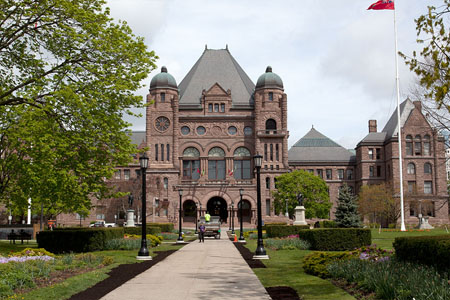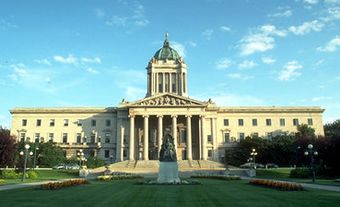Canada is a federal state. This means that the powers and duties of government are split between two levels. There is one national (central, or federal) government and many smaller regional (provincial) ones. The areas of jurisdiction for each level were first outlined at the Quebec Conference in 1864. (See Quebec Resolutions.) They are enshrined in the Constitution Act, 1867. They have been a source of debate and tension between the provinces and the federal government since Confederation. (See Federal-Provincial Relations.) Despite that, this part of the Constitution has remained largely unchanged since then.

Historical Background
The Fathers of Confederation first assigned the powers of the federal and provincial governments during their talks at the Quebec Conference in 1864. (See Quebec Resolutions.) These were refined and formally spelled out in the British North America Act (now called the Constitution Act, 1867) in 1867. They were interpreted, or judged, by the Judicial Committee of the Privy Council until 1949. From then on, they were judged by the Supreme Court of Canada.
The allotment of executive power (the prime minister, premiers and their Cabinets) is similar to that of legislative power. The distribution of powers among Canadian courts is also split, to some extent. But most of it falls under the federal government.
How Power is Divided
Section 91 of the Constitution Act, 1867 grants broad powers to the federal government. Its legislative goal is to ensure the “Peace, Order and good Government of Canada, in relation to all Matters not coming within the classes of subjects by this Act assigned exclusively to the Legislatures of the Provinces.” A key principle of the Fathers of Confederation was that Parliament would have power over matters of national interest. Issues of regional interest would be given to the provinces.
Quebec was governed by a Civil Code. So the provinces were granted jurisdiction over property and civil rights. Quebec was excluded from section 94. It allowed for the standardization of private law for the rest of the provinces.
Federal Powers
Parliament was also given greater residuary jurisdiction. This means that all powers (and new powers arising in the future) not given to the provinces would go to the federal government. The only requirement is that they be of a general, and not local, nature. Over time, the courts have defined federal residuary power to include: the incorporation of businesses with federal objectives; aeronautics; radio; television; nuclear energy; the national capital; offshore mineral rights; official languages in the federal sphere; citizenship; foreign affairs; the control of drugs; and emergency powers in peace and war. (See also War Measures Act; Emergencies Act.)
Other areas of federal jurisdiction include: trade and commerce; direct and indirect taxation; currency; the postal service; the census and statistics; national defence; the federal civil service; navigation; fisheries; banking; copyright; Indigenous peoples and reserves; citizenship; marriage and divorce; criminal law; prisons; and interprovincial works.
Amending Powers
The division of powers can be changed. For example, Parliament gained power over employment insurance through a constitutional amendment (change) in 1940. In 1949, also by amendment, Parliament was granted the power to change the Constitution. The only exceptions are in matters affecting provincial powers. However, in a 1949 decision on the Senate, the Supreme Court restricted the interpretation of the phrase “Constitution of Canada.” It stated that this phrase in section 91.1 of the Constitution Act, 1867 referred to the internal federal Constitution. It did not refer to the Constitution of all Canada. For example, Parliament could not abolish the Senate. It represents the provinces and is not solely a federal concern.
The Constitution Act, 1982 repealed (cancelled) section 91.1. As a result, section 44 of the Act states that, subject to provincial approval in certain cases, “Parliament may exclusively make laws amending the Constitution of Canada in relation to the executive government of Canada or the Senate and House of Commons.” In 2014, the Supreme Court made the issue clearer. It ruled that changes to the makeup of the Senate and the appointment of senators must adhere to the 7/50 rule. It requires the consent of the federal government and seven provinces with at least 50 per cent Canada’s population. The court also ruled that abolishing the Senate would need the consent of the federal government and all 10 provinces.
The provinces have had the right to amend their internal constitutions (except in relation to the office of the lieutenant-governor) since 1867.
Provincial Powers
Among other things, the provinces have power over: their internal constitutions; direct taxation in the province; municipalities; school boards; hospitals; property and civil rights (their largest area of jurisdiction). They also oversee civil and criminal law; fines for breaking provincial statutes; prisons; celebration of marriage; provincial civil service; local works; and corporations with provincial goals.
The courts’ interpretations of federal power over commerce have tended to be restrictive. Their interpretations of provincial power over property and civil rights have tended to be more liberal.

Crossover Powers
There are four areas that are shared by the provinces and the federal government: agriculture, immigration, old-age pensions, and supplementary benefits. In the case of dispute, federal law prevails for areas under section 95 (agriculture and immigration). Provincial law prevails for those under section 94A (old age pensions). Education is granted to the provinces. But it is subject to certain religious guarantees.
Each level of government must stay within its own sphere. However, there have been many times where one has assumed powers that did not clearly belong to it. For example, the provinces have changed some indirect taxes, such as sales and purchase taxes, into direct ones.
The power to spend money remains a vague and disputed area. Parliament assumes that it may spend where it does not necessarily have the power to pass laws. Such spending is usually well received by the provinces when it applies to equalization payments. But it is frowned upon when it infringes on provincial fields such as health, social security and education.

Equalization and Natural Resources
Under the Constitution Act, 1982, equalization is enshrined in section 36. Equalization ensures that all Canadians have access to similar public services at similar levels of taxation. However, the way to put it into practice is unclear.
In 1982, the provinces’ power over natural resources was enlarged to include shared power in interprovincial commerce and marketing. The provinces have also been granted the power of indirect taxation of their natural resources. (See Intergovernmental Finance).
Federal-Provincial Tension
The history of Canadian federalism is basically a list of disputes over the distribution of powers. From the 1880s until the 1930s, federal powers were reduced. This was largely because the Judicial Committee of the Privy Council ignored the centralist desires of many (but not all) of the Constitution’s authors. Instead, it favoured provincial autonomy. The Supreme Court of Canada, on the other hand, has generally strengthened the powers of the federal government.
There have been various constitutional conferences between the provinces and the federal government. Despite this, there have been few changes to the division of powers. The Meech Lake Accord would have expanded provincial power in appointments to the Supreme Court and the Senate. It also would have slightly enhanced provincial power in the shared area of immigration. Overall, however, it would have produced no major changes to the distribution of powers set out in the Constitution.

 Share on Facebook
Share on Facebook Share on X
Share on X Share by Email
Share by Email Share on Google Classroom
Share on Google Classroom







